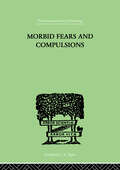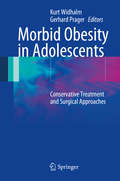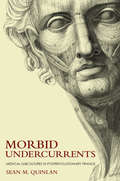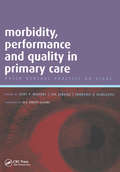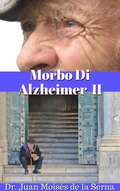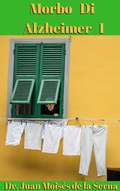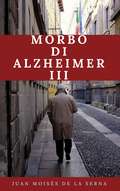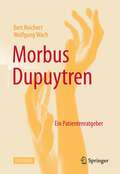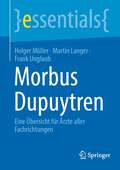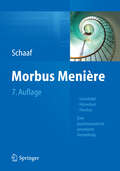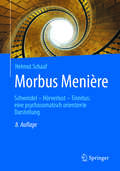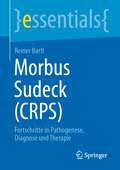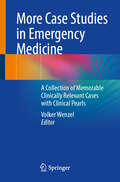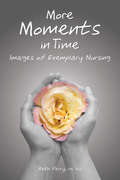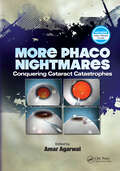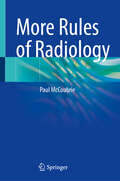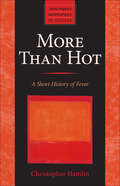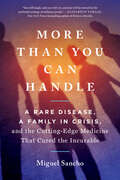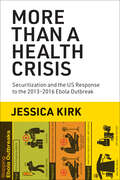- Table View
- List View
Morbid Fears And Compulsions: THEIR PSYCHOLOGY AND PSYCHOANALYTIC TREATMENT
by Frink, H. W.First Published in 1999. Routledge is an imprint of Taylor & Francis, an informa company.
Morbid Medicine and Miracle Cures (Fountas & Pinnell Classroom, Guided Reading)
by Christine StevensNIMAC-sourced textbook. Searching for Cures. Flesh-eating maggots. Saliva from the vampire bat. Powder from the rhino horn. And a parasite that fights cancer. Sick people will try anything if it offers a chance at survival. Modern science helps us evaluate some bizarre medical practices from the past and present to determine which cures work—and why.
Morbid Obesity
by Jay B. Brodsky Adrian Alvarez Jay B. Brodsky Hendrikus J. M. Lemmens John M. Morton Adrian Alvarez Hendrikus J. M. LemmensFor surgeons, anesthesiologists, and others in the field, Alvarez et al. , anesthesiologists and one surgeon from Argentina and the US, compile 25 chapters that discuss an important topic in surgery: the perioperative to post-operative anesthetic management of obese and morbidly obese patients. Anesthesiologists, surgeons, and other medical specialists from the US, South America, and Europe address pathophysiology; preparation and evaluation; monitoring, airway management, and anesthesia; post-operative conditions, including intensive care management, long-term complications, nursing considerations, and anesthesia for post-bariatric surgery patients; and special topics like organizing a team and the obese parturient. This edition has been updated and revised and emphasizes bariatric surgery and applications of its lessons to other procedures. It has fewer chapters, with consolidation of chapters on cardiac pathophysiology and disease and anesthetic agents, new chapters on pathophysiology of the pneumoperitoneum, rhabdomyolysis, and other topics; and additional or expanded chapters on special topics like informed consent and adolescents. Annotation ©2010 Book News, Inc. , Portland, OR (booknews. com)
Morbid Obesity in Adolescents
by Kurt Widhalm Gerhard PragerAs the worldwide prevalence of morbid obesity among adolescents continues to rise, recent years have seen a large increase in the performance of adolescent bariatric surgery. While surgical intervention often becomes necessary when conservative weight-loss therapies have failed, no standards regarding the post-operative regimen and long-term management of adolescent patients have been established. Thus, the treatment of obesity and its co-morbidities requires a multidisciplinary approach, taking into account epidemiological, clinical, nutritional and genetic aspects of morbid obesity in the pediatric age group. This volume discusses both conventional therapy and surgical options for morbid obesity in the pediatric age group. In the first part, obesity-related diseases, genetics and psychological factors are analyzed. The second part focuses on current bariatric surgery procedures, including dietary restrictions and guidelines to prevent nutritional deficiencies common after surgery. Therefore, the book will prove an invaluable resource for pediatricians, surgeons, nutritionists, dieticians and all other health professionals who treat adolescent obesity.
Morbid Undercurrents: Medical Subcultures in Postrevolutionary France
by Sean M. QuinlanIn Morbid Undercurrents, Sean M. Quinlan follows how medical ideas, stemming from the so-called birth of the clinic, zigzagged across the intellectual landscape of the French Revolution and its aftermath. It was a remarkable "hotspot" in the historical timeline, when doctors and scientists pioneered a staggering number of fields—from forensic investigation to evolutionary biology—and their innovations captivated the public imagination. During the 1790s and beyond, medicine left the somber halls of universities, hospitals, and learned societies and became profoundly politicized, inspiring a whole panoply of different—often bizarre and shocking—subcultures. Quinlan reconstructs the ethos of the time and its labyrinthine underworld, traversing the intersection between medicine and pornography in the works of the Marquis de Sade, efforts to create a "natural history of women," the proliferation of sex manuals and books on family hygiene, anatomical projects to sculpt antique bodies, the rage for physiognomic self-help books that taught readers to identify social and political "types" in post-revolutionary Paris, the use of physiological medicine as a literary genre, and the "mesmerist renaissance" with its charged debates over animal magnetism and somnambulism. In creating this reconstruction, Quinlan argues that the place and authority of medicine evolved, at least in part, out of an attempt to redress the acute sense of dislocation produced by the Revolution. Morbid Undercurrents exposes how medicine then became a subversive, radical, and ideologically charged force in French society.
Morbidity, Performance and Quality in Primary Care: A Practical Guide, v. 2
by Rajat Chowdhury Gert P. Westert Lea Jabaaij Els Borst-EilersThis book is based on the findings of a nationwide study, the aim of which was to analyse general practitioners' performance as gatekeepers of the Dutch healthcare system. The study was undertaken along six themes: the health of the population; inequalities in health; utilisation of care; quality of care; communication; organisation and workload. Morbidity, Performance and Quality in Primary Care involves 400,000 patients, 1.5 million recorded GP-patient contacts and 2.1 million drug prescriptions. This survey appears at a timely moment. It coincides with the recent interest in primary care arising not only from the growing importance of cost containment in healthcare, but also from the now firmly established association between the life expectancy of a population and the existence of a strong primary care sector. The international interest in the Dutch situation is reflected in several chapters, where experts from all over the world put Dutch general practice into an international perspective.
Morbo Di Alzheimer II
by Juan Moises de la Serna Elisabetta MannoniL’obiettivo di questo e-book è servire da primo avvicinamento per coloro che vivono in prima persona o all’interno della loro famiglia la malattia di Alzheimer. Questo libro prova a presentare in modo chiaro i risultati delle ultime ricerche sulla malattia di Alzheimer, al fine di rispondere alle domande più importanti: che sintomi provoca? come viene diagnosticato? quanti ne sono affetti?
Morbo di Alzheimer - I
by Juan Moises de la Serna Matteo SerragoL'e-book "morbo di Alzheimer - I" spiega in maniera più semplice e con un linguaggio alla portata di tutti il morbo di Alzheimer, la famosa malattia neurodegenerativa da tutti conosciuta per i suoi irreversibili danni alla memoria. Questo e-book offre quindi una spiegazione chiara ed efficace di come la malattia si sviluppa, se ha cause genetiche, chi viene colpito maggiormente e quali sono gli sforzi che la scienza fa ogni giorno per cercare di arginare un male tanto temuto quanto difficile da curare.
Morbo di Alzheimer III
by Juan Moises de la SernaCome viene trattato? Qual è la sua evoluzione? Come si previene? Scopri gli ultimi progressi nella prevenzione e nel trattamento della malattia di Alzheimer. Uno segli aspetti importanti di una malattia è come superarla, curarla e il suo trattamento. A questo proposito sono stati effettuati progressi nel campo della ricerca sul trattamento e la prevenzione della malattia di Alzheimer, presentati in qusto testo. Destinatari: - Professionisti della salute che desiderano approfondire le proprie conoscenze sulla signosi e sul trattamento della malattia di Alzheimer. - Insegnanti che vogliono offrire informazioni aggiornate sulla malttia di Alzheimer ai loro studenti. - A tutti coloro che soffrono della malattia di Alzheimer e i loro parenti, in modo che sappiano comportarsi di fronte a questa malattia. In seguito vengono presentati gli argomenti principali di questo testo: - Trattamento dell'Alzheimer: nonostante la limitata efficacia dei trattamenti attuali, ogni giorno vengono fatte nuove scoperte per affrontare questa malattia. - Evoluzione del morbo di Alzhiemer: il morbo di Alzheimer è definito come una malattia progressiva, cioè, col tempo, si perdono le capacità cognitive di coloro che ne soffrono. Scopri come combatterlo. Prevenzione del morbo di Alzheimer: questo è probabilmente uno degli aspetti più sconosciuti delle ultime scoperte sul morbo di Alzheimer.
Morbus Dupuytren: Ein Patientenratgeber
by Wolfgang Wach Bert ReichertDieser Ratgeber wendet sich an Betroffene und interessierte Menschen, die sich ein eigenes Bild von der Krankheit „Morbus Dupuytren/Dupuytren-Krankheit“ machen wollen. Wird aus meiner Dupuytren-Erkrankung eine Kontraktur? Muss ich mich operieren lassen oder gibt es auch andere Behandlungen? Kann ich vorbeugen? Das sind Beispiele für Fragen, die in der Sprechstunde und auch zunehmend über Email und soziale Netze gestellt werden. Dieses Buch wird diese und mehr Fragen übersichtlich und kompakt beantworten! Neben der Perspektive des Arztes werden auch Erwartungen und Erfahrungen der Patienten dargestellt.
Morbus Dupuytren: Eine Übersicht für Ärzte aller Fachrichtungen (essentials)
by Martin Langer Frank Unglaub Holger MüllerDer Morbus Dupuytren beschreibt eine fibroproliferative Erkrankung der Hohlhandaponeurose mit Teilen des subkutanen Fasersystems an Hohlhand und Fingern und stellt als multifaktorielle Erkrankung mit erblicher Veranlagung und Hang zum Rezidiv für den behandelnden Arzt eine therapeutische Herausforderung dar. Es handelt sich dabei vorwiegend um eine Erkrankung des älteren Menschen, die hauptsächlich in Nordeuropa auftritt. Zur Behandlung der Dupuytren-Kontraktur haben sich neben der minimal invasiven perkutanen Nadelaponeurotomie, vor allem die partielle Aponeurektomie als chirurgisches Verfahren durchgesetzt. Weitere Therapieverfahren sowie die Besonderheiten bei der operativen Therapie einer Rezidiv-Kontraktur werden ausführlich dargestellt.
Morbus Menière
by Helmut SchaafIn dem Band erläutert der Autor die typischen Anzeichen des Morbus Menière, er legt dar, was man über die Krankheit wissen sollte und welche Behandlungskonzepte es gibt. Alle Aspekte der Erkrankung - Grundlagen, Auswirkungen und Therapiemöglichkeiten - sind leicht verständlich zusammengefasst, so dass Betroffene und behandelnder Arzt gleichermaßen davon profitieren. Die neu bearbeitete 7. Auflage informiert über aktuelle medizinische Möglichkeiten und Grenzen und weist auf verfeinerte psychosomatische Vorgehensweisen im Umgang mit der Krankheit hin.
Morbus Menière: Schwindel - Hörverlust - Tinnitus: eine psychosomatisch orientierte Darstellung
by Helmut SchaafIn dem Band erläutert der Autor die typischen Anzeichen des Morbus Menière, er legt dar, was man über die Krankheit wissen sollte und welche Behandlungskonzepte es gibt. Alle Aspekte der Erkrankung – Grundlagen, Auswirkungen und Therapiemöglichkeiten – sind leicht verständlich zusammengefasst, so dass Betroffene und behandelnder Arzt gleichermaßen davon profitieren. Die neu bearbeitete 7. Auflage informiert über aktuelle medizinische Möglichkeiten und Grenzen und weist auf verfeinerte psychosomatische Vorgehensweisen im Umgang mit der Krankheit hin.
Morbus Menière: Schwindel – Hörverlust – Tinnitus: eine psychosomatisch orientierte Darstellung
by Helmut SchaafIn dem Band erläutert der Autor die typischen Anzeichen des Morbus Menière, er legt dar, was man über die Krankheit wissen sollte und welche Behandlungskonzepte es gibt. Alle Aspekte der Erkrankung – Grundlagen, Auswirkungen und Therapiemöglichkeiten – sind leicht verständlich zusammengefasst, so dass Betroffene und behandelnder Arzt gleichermaßen davon profitieren. Die neu bearbeitete 7. Auflage informiert über aktuelle medizinische Möglichkeiten und Grenzen und weist auf verfeinerte psychosomatische Vorgehensweisen im Umgang mit der Krankheit hin.
Morbus Sudeck: Fortschritte in Pathogenese, Diagnose und Therapie (essentials)
by Reiner BartlIn diesem essential wird das „Complex Regional Pain Syndrome“ (CRPS), früher als „Morbus Sudeck“ bezeichnet, als zermürbende, die Lebensqualität zerstörende chronische Schmerzkrankheit vorgestellt. Sie manifestiert sich als lokale akute Entzündung oft nach Bagatelltraumen, charakterisiert durch Schmerz, Schwellung, Temperaturunterschiede und livide Verfärbung der betroffenen Extremität. Neue Erkenntnisse in der Pathophysiologie dieser immer noch rätselhaften Erkrankung führten zu Fortschritten im Verständnis, in der Diagnostik und vor allem in der Therapie. Das mit dem CRPS assoziierte Knochenmarködem ist heute mit Bisphosphonat- Infusionen heilbar. Sonderformen des CRPS bei Kindern und Jugendlichen, bei Schwangeren und im hohen Alter werden vorgestellt.
More Case Studies in Emergency Medicine: A Collection of Memorable Clinically Relevant Cases with Clinical Pearls
by Volker WenzelFollowing the successful book Case Studies in Emergency Medicine, More Case Studies in Emergency Medicine is another book with real, exciting and instructive case studies. Emergency physicians with many years of experience describe often dramatic and humanly touching emergency scene calls with which they have been confronted in the course of their professional lives. Each case is discussed based on the current literature and finishes with a conclusion to help in future practice. It is aimed at all those who work in emergency medicine or the emergency medical service and want to learn from the experience of their colleagues. Emergency physicians and nurses, paramedics and emergency medical technicians receive valuable tips for their own future work.
More Case Studies in Stroke
by Louis R. Caplan Michael G. Hennerici Rolf Kern Louis R. Caplan Kristina Szabo Michael G. Hennerici Rolf KernStroke is the leading cause of permanent disability, including post-stroke dementia, pain, depression, and personality changes. While large clinical trials reflect information about large stroke populations, the presentation of each and every stroke patient is individual and special. More Case Studies in Stroke presents a new selection of stroke cases from seven countries prepared by practising stroke physicians. The book includes both common and unusual cases, as well as misleading cases of diseases mimicking stroke. The aim is to reinforce diagnostic skills through careful analysis of individual presenting patterns, and to guide treatment decisions. Each case consists of a clinical history, examination findings and special investigations, followed by diagnosis and discussion. The outline of the actual diagnostic process, including the use of modern diagnostic tools, decision making and course, challenge the reader at all stages of their career from medical students to neurologists and stroke physicians.
More Phaco Nightmares: Conquering Cataract Catastrophes
by Amar AgarwalEven the most experienced cataract surgeon can encounter stressful situations in the operating room. With the new edition of More Phaco Nightmares: Conquering Cataract Catastrophes, surgeons can be prepared to manage unavoidable complications with ease.Dr. Amar Agarwal, along with over 35 of today’s cataract surgery leaders, explain all there is to know about phacoemulsification and bring their extensive experience with their own surgical nightmares. The book contains 5 sections that gradually escalate from the basics to nightmares, furnishing phaco surgeons with complicated scenarios and the essential guidance to assess, manage, and resolve.Featuring updated content and brand new, state-of-the-art chapters on a variety of complex situations, More Phaco Nightmares is the toolkit surgeons need to stay in control when facing unique and especially challenging intra- and postoperative complications.Sample chapters include: The Phaco Machine Air Pump, Gas-Forced Infusion, and Active Fluidics Intraoperative Floppy Iris Syndrome Single-Pass Four-Throw Pupilloplasty Management of Capsule Rupture at Cataract Surgery Malpositioned Intraocular Lens Optic Capture Glued Intraocular Lens Management and Prevention of Negative Dysphotopsia Pseudophakic Cystoid Macular Edema More than 350 illustrations and photographs supplement the text, providing visual as well as textual references for each case. Plus, an accompanying video website contains over 4 hours of new, original, high-quality video content, offering additional visual learning to demonstrate the techniques discussed.Offering cutting-edge information, More Phaco Nightmares: Conquering Cataract Catastrophes will guide surgeons on how to mitigate the common problems and unanticipated disasters that may arise for even the most experienced surgeons.
More Rules of Radiology
by Paul McCoubrieBased on the social media success of my series of articles around ‘The Rules of Radiology’ this follows on from the first volume (‘The Rules of Radiology’), published in 2021. ‘More Rules of Radiology’ is the second and final volume that contains Rules 51-100. The Rules provide a guide to what radiology is and what radiologists do. Or rather what radiology should be and what radiologists should do. This book and its prior sister volume looks hard not just at radiology but also provides a distinctly wry look at the curious and occasionally alien world of hospital-based medical practice. I ask questions and poke fun but it is serious intent. My motto is ‘first make you laugh, then make you think’. Or, as George Bernard Shaw wrote, “My method is to take the utmost trouble to find the right thing to say, and then to say it with the utmost levity”. Each of the Rules addresses an important part of professional practice. I analyse the underpinning concepts of modern radiology, critically reflect on underlying assumptions, pose thoughtful questions and provide measured debate. All sprinkled with a mixture of weak jokes, puns and gratuitous word play. As a relatively young but rapidly expanding specialty, there has been no guide for radiologists, no moral compass. Until now. I provide opinions and guidance on key matters; sometimes controversial but always reasoned. The hope is to provide the reader with much food for thought. Not only that but this volume and its predecessor aim to provide a manifesto for radiologists across the globe to raise their game and serve their patients better.
More Than Caring
by Josie MetcalfeIntensive care Lauren Scott has never found it easy to invest her feelings in relationships. Instead she's invested her care and attention in her nursing patients. Then handsome hospital administrator Marc Fletcher comes to her rescue. As Lauren becomes caught up in a case of mistaken identity, Marc becomes ever more protective--and attentive. Finally Lauren has found a man she can trust. But Marc has also been running away from relationships, and if they are to have a chance of a life together, Lauren must persuade Marc to accept some TLC in return.
More Than Hot: A Short History of Fever (Johns Hopkins Biographies of Disease)
by Christopher HamlinA conceptual and cultural history of fever, a universally experienced and sometimes feared symptom.Winner of the CHOICE Outstanding Academic Title of the Choice ACRLChristopher Hamlin’s magisterial work engages a common experience—fever—in all its varieties and meanings. Reviewing the representations of that condition from ancient times to the present, More Than Hot is a history of the world through the lens of fever. The book deals with the expression of fever, with the efforts of medical scientists to classify it, and with fever’s changing social, cultural, and political significance. Long before there were thermometers to measure it, people recognized fever as a dangerous, if transitory, state of being. It was the most familiar form of alienation from the normal self, a concern to communities and states as well as to patients, families, and healers. The earliest medical writers struggled for a conceptual vocabulary to explain fever. During the Enlightenment, the idea of fever became a means to acknowledge the biological experiences that united humans. A century later, in the age of imperialism, it would become a key element of conquest, both an important way of differentiating places and races, and of imposing global expectations of health. Ultimately the concept would split: "fevers" were dangerous and often exotic epidemic diseases, while "fever" remained a curious physiological state, certainly distressing but usually benign. By the end of the twentieth century, that divergence divided the world between a global South profoundly affected by fevers—chiefly malaria—and a North where fever, now merely a symptom, was so medically trivial as to be transformed into a familiar motif of popular culture.A senior historian of science and medicine, Hamlin shares stories from individuals—some eminent, many forgotten—who exemplify aspects of fever: reflections of the fevered, for whom fevers, and especially the vivid hallucinations of delirium, were sometimes transformative; of those who cared for them (nurses and, often, mothers); and of those who sought to explain deadly epidemic outbreaks. Significant also are the arguments of the reformers, for whom fever stood as a proxy for manifold forms of injustice. Broad in scope and sweep, Hamlin’s study is a reflection of how the meanings of diseases continue to shift, affecting not only the identities we create but often also our ability to survive.
More Than Medicine: Nurse Practitioners and the Problems They Solve for Patients, Health Care Organizations, and the State (The Culture and Politics of Health Care Work)
by LaTonya J. TrotterIn More Than Medicine, LaTonya J. Trotter chronicles the everyday work of a group of nurse practitioners (NPs) working on the front lines of the American health care crisis as they cared for four hundred African American older adults living with poor health and limited means. Trotter describes how these NPs practiced an inclusive form of care work that addressed medical, social, and organizational problems that often accompany poverty. In solving this expanded terrain of problems from inside the clinic, these NPs were not only solving a broader set of concerns for their patients; they became a professional solution for managing "difficult people" for both their employer and the state. Through More Than Medicine, we discover that the problems found in the NP's exam room are as much a product of our nation's disinvestment in social problems as of physician scarcity or rising costs.
More Than You Can Handle: A Rare Disease, A Family in Crisis, and the Cutting-Edge Medicine That Cured the Incurable
by Miguel SanchoThe personally harrowing and medically enthralling story of a family's struggle to save a child from a deadly immune deficiency.A journey through the deepest valleys and highest peaks of parenting. When a two-month-old baby falls ill, his apparently ordinary symptoms turn out to signal a rare and lethal immune deficiency. For parents Miguel Sancho and Felicia Morton, the discovery that their son, Sebastian, has chronic granulomatous disease (CGD) upends their lives and leaves the family with few options, all of them terrifying. With Sebastian at constant risk of deadly infection, they spend the next six years in some degree of self-quarantine, with all its attendant anxieties and stressors, as they struggle to keep their son alive, their marriage intact, and themselves sane.The quest for a cure leads them into the alternate universe of the rare-disease community, and to the cutting edge of modern medicine, as their personal crises send them fumbling through various modalities of self-help, including faith, therapy, and meditation. With brutal honesty, Sancho describes how his struggles derail his career, put his marriage on life support, get his family evicted from a Ronald McDonald House, and ruin a Make-A-Wish trip.Sancho's riveting tale of the diagnosis and treatment of his son's illness takes us deep inside the workings of the immune system, and into the radically innovative treatment used to repair it. Ultimately Sebastian is saved with a stem cell transplant using discarded umbilical cord blood, a groundbreaking technique pioneered and practiced by the medical wizards at Duke University Hospital.Deeply researched and darkly humorous, this is a wrenching tale with a triumphant ending.
More Than a Health Crisis: Securitization and the US Response to the 20132016 Ebola Outbreak
by Jessica KirkHow the West African Ebola epidemic was transformed from an urgent and distant tragedy into an existential threat to American lives—establishing the dynamics that would later dominate the US response to epidemics such as COVID-19.In 2014 and 2015, the viral Ebola epidemic in West Africa inspired breathless US media coverage and became the subject of heated public debate over just how to understand the security issue that the outbreak presented. Was it a security concern because of the lives at risk in West Africa? Or because of its threat to regional and global stability? Or was it potentially a threat to the American people? In More Than a Health Crisis, Jessica Kirk reveals how these varied positions spoke to divisions within the American public, concerning how we think about and respond to uncertainty, competing expertise, and securitization.Kirk insightfully examines how experts in different fields offered conflicting assessments of the risks posed by Ebola, and then goes on to analyze how the US press undermined the authority of the public health experts who accurately predicted that the virus posed little danger to Americans. Reading the media coverage of the Ebola epidemic as a case study in the biopolitics of fear, Kirk considers how the US response reflected not only anxieties over globalization but also long-held narratives about the &“Dark Continent.&” Finally, Kirk shows how the US and global public response to the Ebola outbreak challenged traditional models of securitization and identifies patterns that have tragically recurred with subsequent epidemics such as COVID-19 and monkeypox.
